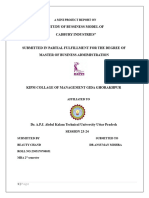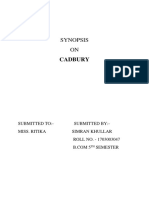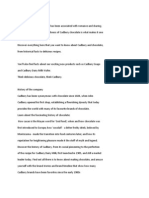Jbims
Jbims
Uploaded by
samip_ssCopyright:
Available Formats
Jbims
Jbims
Uploaded by
samip_ssOriginal Title
Copyright
Available Formats
Share this document
Did you find this document useful?
Is this content inappropriate?
Copyright:
Available Formats
Jbims
Jbims
Uploaded by
samip_ssCopyright:
Available Formats
1
ABSTRACT
The caselet primarily deals with the worm controversy in October 2003 when a stockiest in Mumbai found worms in Cadbury's chocolates. It discusses the impact of this incident on Cadbury's reputation and ethical image. It describes the steps taken by the company to regain its lost image and briefly examines how Cadbury's competitors gained from the worm controversy. It also presents an overview of the Indian chocolate market.
EARLY
HISTORY
The history of Cadbury as manufacturers of chocolate products in Birmingham dates
back to the early part of the 19th century, when John Cadbury opened a shop in the centre of the city, trading as a coffee and tea dealer. Soon a new sideline was introduced - cocoa and drinking chocolate, which he prepared himself using a mortar and pestle. The founding of the Cadbury business dates back to 1831 when John Cadbury first made cocoa products on a factory scale in an old malt house in Crooked Lane, Birmingham. In 1847 the business moved to larger premises in Bridge Street, which had its own private canal spur linking the factory via the Birmingham Navigation Canal to the major ports of Britain. Business continued at the Bridge Street site for 32 years and by 1878 the workforce had expanded to 200, so more space was needed. This heralded the move to Bournville and the building of what is now one of the largest chocolate factories in the world. John Cadbury retired in 1861 handing over the business to his eldest sons Richard and George. It is to their leadership that the success of the enterprise is owed as the company prospered. The origin of the group goes back over two centuries. Some of the most loved international brands are from the stable of Cadbury Schweppes Cadbury Dairy Milk, Dr Pepper, Flake, Trebor Basset, Snapple, Motts and with the acquisition of Adams, brands like - Halls, Clorets, Trident, Dentyne and Bubbas bubble gum range will now be part of the Groups portfolio. 55,000 people populate the humming offices of Cadbury Schweppes across the globe.
You might also like
- The Story of CadburyDocument10 pagesThe Story of Cadburyrakesh_sharma10No ratings yet
- Success Story of CadburyDocument2 pagesSuccess Story of CadburyVedangi ModNo ratings yet
- Project Report On CadBury Scheweppes and Cadbury PakistanDocument19 pagesProject Report On CadBury Scheweppes and Cadbury PakistanSadiq SagheerNo ratings yet
- Cadbury and Nestle: Economic Analysis ofDocument36 pagesCadbury and Nestle: Economic Analysis ofHarish KumarNo ratings yet
- The History Company (Cadbury)Document5 pagesThe History Company (Cadbury)Hazif HadzlyNo ratings yet
- CadburyDocument82 pagesCadburyRoxanne Joyce GadianoNo ratings yet
- Cadbury GokulDocument69 pagesCadbury GokulGokulkrishnaNo ratings yet
- Cadbury Vs NestleDocument31 pagesCadbury Vs NestleSai Kashikedar100% (1)
- C Was A BritishDocument21 pagesC Was A BritishAshish VermaNo ratings yet
- Cad BuryDocument49 pagesCad BuryRomit ParikhNo ratings yet
- Cadbury PLCDocument7 pagesCadbury PLCLavan TokasNo ratings yet
- The Story of Cadbury Early Days - A One Man Business: INTRODUCTION TO CADBURY - October 15th, 2010Document5 pagesThe Story of Cadbury Early Days - A One Man Business: INTRODUCTION TO CADBURY - October 15th, 2010mm_ammu07No ratings yet
- Cadbury PLC: Cadbury PLC Is A British Confectionery Company, The Industry'sDocument19 pagesCadbury PLC: Cadbury PLC Is A British Confectionery Company, The Industry'sYusuf TinwalaNo ratings yet
- Cadbury PLCDocument13 pagesCadbury PLCvinayak0304No ratings yet
- Cadbury India LimitedDocument32 pagesCadbury India LimitedYuvrajNo ratings yet
- Background CarburyDocument5 pagesBackground CarburyBelen IbañezNo ratings yet
- HistoryDocument18 pagesHistorydgangani92No ratings yet
- CadburyDocument2 pagesCadburyBeniah LyNo ratings yet
- Cadbury Marketing StrategyDocument46 pagesCadbury Marketing StrategyCool anime yoNo ratings yet
- Cadbury HistoryDocument3 pagesCadbury HistoryKARUNASONINo ratings yet
- Early History: Cadbury PLC Is A BritishDocument24 pagesEarly History: Cadbury PLC Is A Britishraman0007No ratings yet
- Cadbury ProfileDocument27 pagesCadbury ProfileAmar Solanke0% (1)
- Cadbury History at A GlanceDocument18 pagesCadbury History at A GlanceKrishna KunwarNo ratings yet
- Black Book CadburyDocument8 pagesBlack Book CadburyshaikhfaisalNo ratings yet
- Class 12 BST ProjectDocument141 pagesClass 12 BST ProjectRajesh KumarNo ratings yet
- Cadbury - IiDocument10 pagesCadbury - IiVibhav NagarsenkarNo ratings yet
- BEAUTY CHANDDocument35 pagesBEAUTY CHANDDKRS BOSSNo ratings yet
- Cadbury - Wikipedia PDFDocument123 pagesCadbury - Wikipedia PDFZubairNo ratings yet
- Study On CadburyDocument36 pagesStudy On CadburySujeet PandeyNo ratings yet
- 1824john Cadbury Opened Bull Street Shop: Chocolate BrandsDocument1 page1824john Cadbury Opened Bull Street Shop: Chocolate BrandsMJ BotorNo ratings yet
- Marketing of CadburyDocument60 pagesMarketing of CadburyAnisa_Rao100% (1)
- Family Tree For YouDocument16 pagesFamily Tree For YouVERANo ratings yet
- Shreya Patel Period 2Document1 pageShreya Patel Period 2Bilypede55No ratings yet
- CadburyDocument2 pagesCadburydundu11No ratings yet
- Table of ContentsDocument38 pagesTable of ContentsAkash DalabeheraNo ratings yet
- Book 9Document105 pagesBook 9din shaNo ratings yet
- Synopsis ON: CadburyDocument5 pagesSynopsis ON: CadburyankitaNo ratings yet
- CadburyDocument82 pagesCadburyprathamesh kaduNo ratings yet
- Dairy Milk Full ProjectyDocument65 pagesDairy Milk Full ProjectyMahesh Kumar0% (1)
- CadburyDocument32 pagesCadburykantinathNo ratings yet
- New Microsoft Office Word DocumentDocument72 pagesNew Microsoft Office Word DocumentGaurav NavaleNo ratings yet
- DIPANSH CADBURYDocument35 pagesDIPANSH CADBURYDKRS BOSSNo ratings yet
- Cadbury Dairy MilkDocument1 pageCadbury Dairy MilkRikin ShahNo ratings yet
- History of CadburyDocument10 pagesHistory of CadburySagu ChudasamaNo ratings yet
- University of Central Punjab: Project: Cadbury CompanyDocument45 pagesUniversity of Central Punjab: Project: Cadbury CompanyBasavaraj B GNo ratings yet
- Cadbury Final ProjectDocument51 pagesCadbury Final ProjectAashika ShahNo ratings yet
- Cadbury Is A BritishDocument1 pageCadbury Is A BritishnarendrNo ratings yet
- University of Central Punjab: Project: Cadbury CompanyDocument44 pagesUniversity of Central Punjab: Project: Cadbury CompanySZANo ratings yet
- And Its Impact 4m Strategic HRM Perspective: KraftDocument4 pagesAnd Its Impact 4m Strategic HRM Perspective: KraftUjjal Kumar ChandraNo ratings yet
- History of CadburyDocument3 pagesHistory of Cadburyisha_2984340No ratings yet
- Minor Project ReportDocument27 pagesMinor Project Reportayushgarg27.sgnrNo ratings yet
- IMC CadburyDocument44 pagesIMC Cadburyhemal choksiNo ratings yet
- MM - Project - (STP Cadbury)Document20 pagesMM - Project - (STP Cadbury)PRADYUMNA KUMAR DASNo ratings yet
- CadburyDocument46 pagesCadburyRohitNo ratings yet
- Cadbury Dairy Milk - WikipediaDocument12 pagesCadbury Dairy Milk - Wikipedianandhinibcom2020No ratings yet
- Story of Cadbury-1Document2 pagesStory of Cadbury-1Mohammed Irshad AnsariNo ratings yet
- Cadbury's Purple Reign: The Story Behind Chocolate's Best-Loved BrandFrom EverandCadbury's Purple Reign: The Story Behind Chocolate's Best-Loved BrandRating: 5 out of 5 stars5/5 (1)



























































